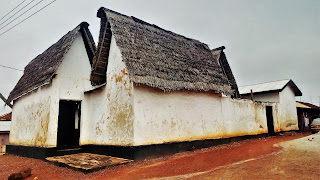Sanctuary located in the Ashanti Region of Ghana
| Ejisu Besease Shrine |
 |
| Image credit to Joy N. Y Agyepong (Commons 4.0) |
|
| Type: |
Ashante Traditional Building |
| Country: |
Ghana |
The Ejisu Besease Shrine is a building of traditional Ashante architecture located in the West African country of Ghana.
History
The shrine was built around 1850 and was used by the Queen Mother of Ejisu, Yaa Asantewaa.
[1] The building was built by Komfo Yaw Awua, also known as Yaw Tano Shrine.
[2] This sanctuary was regularly consulted in case of events, an example of this is the visit of Yaa Asantewaa to this temple during 1900 before the battle between the Ashanti and British empires led by her.
[3] In 1980, the Asante buildings were inscribed on the UNESCO World Heritage List. The first restoration of the roof of the shrine was carried out by the Ghana Museums and Monuments Board (GMMB) in collaboration with CRATerre ENSAG in 1998. The GMMB has restored parts of the building in 2009 and 2012, specifically in the latter year the repairs to the building were due to heavy rainfall in the region. In addition, also in 2012, these traditional Asante buildings were included in the World Monuments Watch.
[4]The building of traditional asante architecture was created with the purpose of housing elements related to a deity.
[5] This deity of Ejisu is known as Yano Taw, the temple has several motifs such as animal figures in addition to having a motif which is that of nnomaa mmienu, which consists of two birds.
[6] The sanctuary has an altar dedicated to the sky god of the Asante religion, this altar is called Nyamedua. The sanctuary had a room dedicated to the people who played the drums for religious ceremonies, in addition to a kitchen where dishes were prepared for the ceremonies.
[7] Besides drums, the temple also has gongs in addition to pots, an Asante fetish dress, ancient coins and stools.
[8]References
The Rough Guide to West Africa. (2008) Rough Guides UK.
The Traditional Shrines in Ashanti Ghana. (2021-12-30) The Ghana HIT
Thierry Joffroy, Sébastien Moriset, Oluremi Funsho Adedayo, Baba Ceesay, Lassana Cissé, et al.. Projets situés: 10 ans d’expérience de terrain / 10 years of field experience. CRAterre, 2009, 2-906901-56-3. hal-00873726 (Page 29)
Conserving the Traditional Architecture of the Asantes. (2013) World Monuments Fund
Studio NYALI: “Architects Need to Reckon with Our Roles as Translators.” (2022-06-16). ArchDaily
Asante, E. A., Kquofi, S., & Larbi, S. (2015). The symbolic significance of motifs on selected Asante religious temples. Journal of Aesthetics & Culture, 7(1), 27006. https://doi.org/10.3402/jac.v7.27006
Ejisu Besease shrine house is one of the 10 remaining old traditional Ashanti architecture. (2021, March 16). GhanaWeb
Asante Traditional Buildings: Survey and Condition Assessment (2014) World Monuments Fund & Ghana Museums and Monuments Board (Page 93)

